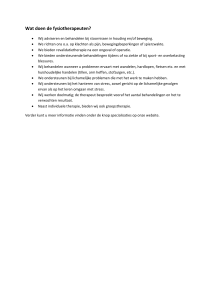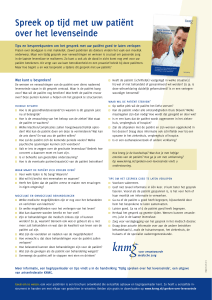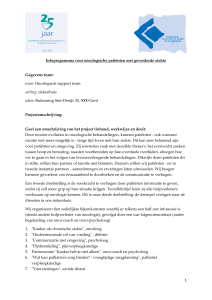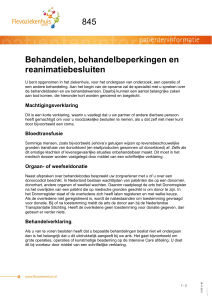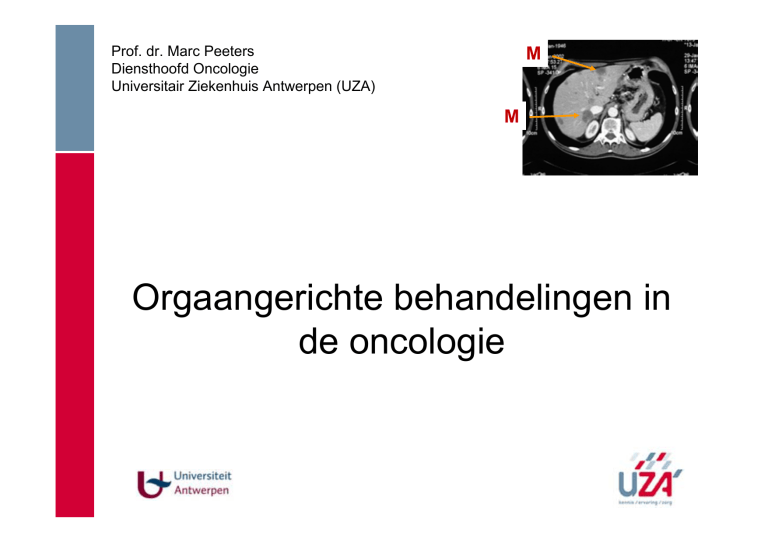
Prof. dr. Marc Peeters
Diensthoofd Oncologie
Universitair Ziekenhuis Antwerpen (UZA)
M
M
Orgaangerichte behandelingen in
de oncologie
(Orgaan)gerichte behandelingen – Overzicht
1. Huidige behandelingen in de oncologie
2. Orgaangerichte behandelingen in de oncologie
3. Radioembolisatie in de oncologie
4. Uitdagingen van orgaangerichte behandelingen
5. Algemene conclusie
Behandelingen in de oncologie
- Diagnose and Staging
- Multidisciplinaire Team Beslissing
- Therapeutisch plan
lokale behandeling
oncologische chirurgie
radiotherapie
orgaan gerichte behandeling
systemische therapie
- Adequate Follow up
Behandelingen in de oncologie
Behandelingen in de oncologie
Curatief
OS
- Adjuvante therapie
- Neo-adjuvante
Doelstelling
Palliatief
QOL
OS
Behandelingen in de oncologie
M
M
M
M
Meer dan 50% van de kankerpatiënten zullen
uitzaaiingen op afstand ontwikkelen
Kanker is in principe dus vaak een systemische
ziekte, die een systemische aanpak behoeft
Behandelingen in de oncologie
• Klassieke empirische chemotherapie (cytotoxisch)
• Hormonale behandelingen
• Immunotherapie
• Doelgerichte therapie (‘targeted’ therapy)
Behandelingen in de oncologie
Year
Drug
Tumor
• <2000
Octreotide anal. NET
• <2000
Interferon
NET
• 2002
Imatinib
GIST
• 2004
Bevacizumab
Colorectal
• 2004
Cetuximab
Colorectal
• 2005
177Lu-DOTA0,
NET
TYR3-octreotate
• 2005
Panitumumab
Colorectal
• 2007
Erlotinib
Pancreas
• 2007
Sorafinib
Liver
• 2009
Trastuzumab
Stomach
• 2010
Sunitinib
pNET
• 2010
Everolimus
pNET
Behandelingen in de oncologie
Orgaangerichte behandelingen in de oncologie
De lever heeft een dubbele bloedvoorziening:
75% via de vena porta
25% via de arteria hepatica
Bij levermetastasen:
80% via de arteria hepatica
Orgaangerichte behandelingen in de oncologie
- Chemoembolisation (1964); floxuridine, oxaliplatin
- Local Ablative Therapies; RadioFrequency, Cryo, Laser,…
- Drug-eluting Beads; irinotecan, doxorubicin
- Radioembolisation; Yttrium-90 microspheres (SIR-Spheres,
TheraSpheres)
Chemoembolisatie
- Door het plaatsen van een catheter in de a. hepatica
kan men een hoge concentratie aan cytostatica geven
a) vermindering aan systemische blootstelling
b) kleinere kans op beschadiging van normaal lever weefsel
- Metastasen van colorectaal carcinoom en HCC
a) CRC : respons rond 50%, doch impact op globale overleving?
b) HCC : vasculaire tumor, doch systemische therapie?
Radioembolisatie – rationale
•Rationale
Dubbele therapeutische werking
embolisatie + lokale radiatie
Radioembolisatie – rationale
•
More precise targeting of the tumor volume
•
Decreased side effects and morbidity
•
Decreased dosage to normal tissues (95% vs. 25-30%)
SIR-Spheres
TheraSphere
biocompatible resin-based spheres (32µm)
insoluble glass microspheres (20-30µm)
40-80.106 microspheres/vial (5 ml)
22000 - 73000 microspheres/mg
average activity/microsphere = 50 Bq
average activity/microsphere = 2500 Bq
tumor burden
target liver volume
Radioembolisatie – patiëntenselectie
Indicaties
Niet-reseceerbare maligne leveraantasting (primair of metastatisch)
Weinig of geen extra-hepatische ziekte
Levensverwachting van minstens 3 maanden
WHO performance status ≤ 2
Contra-indicaties
- Absoluut
• Zwangerschap en borstvoeding
• Hepatopulmonale shunting met verwachte dosis thv. longen > 30Gy
• Niet door embolisatie te corrigeren flow naar de GI tractus
- Relatief
• Te verwachten beperkte leverreserve (dosisreductie?)
• Hepatopulmonale shunting < 20% (dosisreductie?)
• Vroegere externe radiotherapie
• Voormalig of nog gepland gebruik van capecitabine
Radioembolisatie – selectie van patiënten
• CT thorax/abdomen : primaire screening
• NMR van de lever : lokale uitgebreidheid
• PET/CT
: uitgebreidheid op afstand
• Volumetrie
Chirurgie
Levergerichte therapie
Systemische therapie
Outcome & QOL
Voorbereiding: pre-SIRS
• Angiografie
– hepatische vasculatuur
– anatomische varianten
• Embolisatie
– collaterale takken naar extrahepatisch
ter voorkoming van toxiciteit
• GI tractus, huid, …
• MAA-scan
– 99mTc gelabeld macro-geaggregeerd
albumine
– simuleren 90Y behandeling
• controle effectiviteit embolisatie
• evaluatie longshunting
Procedure: SIRS
•
toediening 90Y microsferen
•
controle scintigrafie (remstraling)
Neveneffecten
• Frequent (20-55%)
meestal zelflimiterend
•
Post-radio-embolisatiesyndroom
•
•
•
•
•
Vermoeidheid
Pijn
Nausea/braken
Anorexie
Koorts
• Zeldzaam (0-5%)
soms levensbedreigend
•
•
•
Gastroduodenale ulcera
Radiatiepneumonitis
Radiation induced liver disease
HCC
- hepatocellulair carcinoom
•
Geen gerandomiseerde studies
•
Palliatieve behandeling inoperabel HCC
–
Vente et al, Eur Radiol. 2009; 19 (4): 951-9.
eh
b
e
v
e
– Hilgard et al, Hepatology. 2010; 52 (5): 1741-9. ti
.
a
C
i
l
• N= 108: mediane TTP 10 m; patiënten zonder trombose
l v. portae
C11,8 m, met trombose 8 m
a
H
p
l
• globaal na 3 m: PR 16%, SD 74% en PD 10%
ls abe
a
e p er
i
t
p 2010;no
– Salem et al, Gastroenterology.
138 (1): 52-64.
o
i
e
• N= 291, globale respons
ig ratioh42%
et(WHO) en 57% (EASL); globale TTP 7.9 maanden
l
i
eChild A 49%, Child B 36%
•
respons ratio
v
en
e
kt
j
i
L
Meldingen van
•
•
an
v
ng
i
l
e
d
an
–
meta-analyse, N= 425: mediane overleving van 7,1 tot 21 m
–
Vente MA, Wondergem M, van der Tweel I, van den Bosch MA, Zonnenberg BA, Lam MG, van Het Schip AD, Nijsen JF. Yttrium-90 microsphere radioembolization for
the treatment of liver malignancies: a structured meta-analysis. Eur Radiol. 2009; 19 (4): 951-9.
–
Hilgard P, Hamami M, Fouly AE, Scherag A, Müller S, Ertle J, Heusner T, Cicinnati VR, Paul A, Bockisch A, Gerken G, Antoch G. Radioembolization with yttrium-90
glass microspheres in hepatocellular carcinoma: European experience on safety and long-term survival. Hepatology. 2010; 52 (5): 1741-9.
–
Salem R, Lewandowski RJ, Mulcahy MF, Riaz A, Ryu RK, Ibrahim S, Atassi B, Baker T, Gates V, Miller FH, Sato KT, Wang E, Gupta R, Benson AB, Newman SB,
Omary RA, Abecassis M, Kulik L. Radioembolization for hepatocellular carcinoma using Yttrium-90 microspheres: a comprehensive report of long-term outcomes.
Gastroenterology. 2010; 138 (1): 52-64.
neoadjuvante behandeling bij geplande resectie, “bridge tot transplantation”
mCRC - gemetastaseerd colorectaal carcinoom
•
“Salvage” behandeling
= patiënten refractair aan klassieke therapeutische opties
•
Vente et al, Eur Radiol. 2009; 19 (4): 951-9.
•
meta-analyse; N= 486
•
globale respons 79% (onafhankelijk voorafgaande therapie)
•
•
Mulcahy et al, Cancer. 2009; 115(9): 1849-58.
•
N= 72; PR 40%, SD 45%, PD 15%;
•
mediane duur tot hepatische progressie 15,4 m
•
•
Vente MA, Wondergem M, van der Tweel I, van den Bosch MA, Zonnenberg BA, Lam MG, van Het Schip AD, Nijsen JF. Yttrium-90 microsphere radioembolization
for the treatment of liver malignancies: a structured meta-analysis. Eur Radiol. 2009; 19 (4): 951-9
Mulcahy MF, Lewandowski RJ, Ibrahim SM, Sato KT, Ryu RK, Atassi B, Newman S, Talamonti M, Omary RA, Benson A 3rd, Salem R. Radioembolization of
colorectal hepatic metastases using yttrium-90 microspheres. Cancer. 2009; 115(9): 1849-58.
Cosimelli et al, Br J Cancer. 2010; 103 (3): 324-31.
•
1ste prospectieve studie (multicentrische fase II studie); N = 50
•
CR 2%, PR 22%, SD 24%, PD 44% (8% niet evalueerbaar)
•
TTP 3,7 m, mediane overleving 12,6 m, met 2- jaarsoverleving van 19,6%
•
significant verschil patiëntengroep respons of progressie: mediane overleving respectievelijk 16 vs 8 m (p= 0,0006);
overleving na 1 jaar bij responders 79% tov 20% bij niet-responders, na 2 jaar respectievelijk 40% en 0%.
•
Cosimelli M, Golfieri R, Cagol PP, Carpanese L, Sciuto R, Maini CL, Mancini R, Sperduti I, Pizzi G, Diodoro MG, Perrone M, Giampalma E, Angelelli B, Fiore F,
Lastoria S, Bacchetti S, Gasperini D, Geatti O, Izzo F; Italian Society of Locoregional Therapies in Oncology (SITILO). Multi-centre phase II clinical trial of yttrium-90
resin microspheres alone in unresectable, chemotherapy refractory colorectal liver metastases. Br J Cancer. 2010; 103 (3): 324-31.
Radioembolisatie – rationale
• Median TTP(liver), mths.
5FU, n=23
5FU + 90Y, n=21
2.1
5.5
HR 0.38
(0.20 – 0.72), p=0.003
• Median TTP, mths.
2.1
4.6
HR 0.51
(0.28 – 0.94), p=0.03
• Median OS, mths.
7.4
9.9
HR 0.92
(0.47–1.78), p=0.80
• Stable disease, n (%)
8 (35)
18 (85)
p=0.001
• Worst toxicity per patient,
Grade 3/4, n (%)
8 (35)
1 (4)
p=0.02
Hendlisz A et al. J Clin Oncol 2010;28:3687-94
Literatuur: mCRC
•
1ste lijn
–
Vente et al, Eur Radiol. 2009; 19 (4): 951-9.
•
meta-analyse; N= 195 patiënten; globale respons 91%
–
–
–
h
c
s
i
t
eu
Vente MA, Wondergem M, van der Tweel I, van den Bosch MA, Zonnenberg BA, Lam MG, van Het Schip AD, Nijsen JF.
Yttrium-90 microsphere radioembolization for the treatment of liver malignancies: a structured meta-analysis. Eur Radiol.
2009; 19 (4): 951-9
p
a
r
he k.chemotherapie +/• gerandomiseerde fase III studie; N= 74; neoadjuvant intrahepatische
t
in elij
SIRS
s
t en TTP
d m tov 59% en 9.7 m
i15.9
a
• combinatiearm signifiicant beter met responsa78%
u
l
p ond
r
a el
a
e
m88 (2):h78-85.
d
Van Hazel et al, J Surg Oncol.
2004;
n
o21;g chemotherapie +/- SIRS
estudie;
v
n
• gerandomiseerde fase
II
N=
e 100% en TTP 18.6m tov bij enkel chemo 60% en 3.6m
lo respons
e
m
• combinatiegroep
globale
b
t
ri m tov 12.8 m
el go
e
• mediane
overleving
29.4
v al
t
k
• na
36
m
36% patiënten combinatiegroep in leven, alle patiënten uit de andere groep
ij
Loverleden.
Gray et al, Ann Oncol. 2001; 12 (12): 1711-20.
–
Gray B, Van Hazel G, Hope M, Burton M, Moroz P, Anderson J, Gebski V. Randomised trial of SIR-Spheres plus
chemotherapy vs. chemotherapy alone for treating patients with liver metastases from primary large bowel cancer. Ann
Oncol. 2001; 12 (12): 1711-20.
–
Van Hazel G, Blackwell A, Anderson J, Price D, Moroz P, Bower G, Cardaci G, Gray B. Randomised phase 2 trial of SIRSpheres plus fluorouracil/leucovorin chemotherapy versus fluorouracil/leucovorin chemotherapy alone in advanced colorectal
cancer. J Surg Oncol. 2004; 88 (2): 78-85.
Literatuur: andere
•
Neuro-endocriene tumoren
–
–
•
Cholangiocarcinoom
–
–
•
Kennedy AS, Dezarn WA, McNeillie P, Coldwell D, Nutting C, Carter D, Murthy R, Rose S, Warner RR, Liu D, Palmedo
H, Overton C, Jones B, Salem R. Radioembolization for unresectable neuroendocrine hepatic metastases using resin
90Y-microspheres: early results in 148 patients. Am J Clin Oncol. 2008 Jun;31(3):271-9.
King J, Quinn R, Glenn DM, Janssen J, Tong D, Liaw W, Morris DL. Radioembolization with selective internal radiation
microspheres for neuroendocrine liver metastases. Cancer. 2008; 113 (5): 921-9.
Saxena A, Bester L, Chua TC, Chu FC, Morris DL. Yttrium-90 radiotherapy for unresectable intrahepatic
cholangiocarcinoma: a preliminary assessment of this novel treatment option. Ann Surg Oncol. 2010; 17 (2): 484-91
Ibrahim SM, Mulcahy MF, Lewandowski RJ, Sato KT, Ryu RK, Masterson EJ, Newman SB, Benson A 3rd, Omary RA,
Salem R. Treatment of unresectable cholangiocarcinoma using yttrium-90 microspheres: results from a pilot study.
Cancer. 2008; 113 (8): 2119-28.
e
d
on
r
rde
Mammacarcinoom
–
–
ek
o
rz
ak
z
od
o
n
jk
i
l
e
n
e
t
lta
u
r es
e
v
–
Coldwell DM, Kennedy AS, Nutting CW. Use of yttrium-90 microspheres in the treatment of unresectable hepatic
metastases from breast cancer. Int J Radiat Oncol Biol Phys. 2007; 69 (3): 800-4
Jakobs TF, Hoffmann RT, Fischer T, Stemmler HJ, Tatsch K, La Fougere C, Murthy R, Reiser MF, Helmberger TK.
Radioembolization in patients with hepatic metastases from breast cancer. J Vasc Interv Radiol. 2008; 19 (5): 683-90.
te
n
sa(uveaal)
• Melanoom
s
e AS, Nutting C, Jakobs T, Cianni R, Notarianni E, Ofer A, Beny A, Dezarn WA. A first report of
r
–
Kennedy
e
Intradioembolization for hepatic metastases from ocular melanoma. Cancer Invest. 2009; 27 (6): 682-90
• Geslacht
M
10 (83.3%)
V
2 (16.7%)
colorectaal carcinoom
8 (66.7%)
cholangiocarcinoom
1 (8.3%)
melanoom
1 (8.3%)
seminoom
1 (8.3%)
sinuscarcinoom
1 (8.3%)
• Leeftijd
mediaan (range)
60.5 jaar (38 – 80)
• Tijd tussen diagnose levermeta’s en SIRS
mediaan (range)
9.5 maanden (4-28)
• Aantal lijnen chemo sinds diagnose meta’s
mediaan (range)
1.5 (1-4)
afwezig
3 (25%)
aanwezig
9 (75%)
mediaan (range)
4.0% (2 - 18)
• Primaire tumor
• Extrahepatische ziekte
• Hepatopulmonale shunt
Symptoom
Aantal patiënten
Periode
Maaglast
9 (75%)
D0 – D3
Vermoeidheid
9 (75%)
D1 – D10
Nausea
6 (50%)
D0 – D7
Anorexie
6 (50%)
D1 – D7
Koorts
2 (16.6%)
D0 – D3
Braken
1 (8.3%)
D0
Majeure toxiciteit
• geen GI ulcera
Twee patiënten met aanhoudende maaglast: negatieve gastroscopie
• geen radiatiepneumonie
• RILD?
• 1 patiënt overleden aan leverfalen, doch manifeste progressie
• 1 patiënt mogelijk RILD, doch belangrijk progressie extra-hepatisch
Veelbelovende techniek
• indicatie en exacte plaats nog onduidelijk
• nood aan verdere prospectieve gerandomiseerde studies
Relatief weinig neveneffecten indien
• grondige patiëntenselectie
• zorgvuldige voorbereiding
Potentieel letale toxiciteiten
• ervaring = toxiciteit
• feed-back en overleg
• herbekijken angio of scintigrafie bij toxiciteit
• moeilijke DD toxiciteit/ziekteprogressie
Aanbevelingen voor gestandaardiseerde aanpak SIRS patiënten
Vooraf
Klinisch nazicht met bijzondere aandacht voor performance status
Labo met cytologie, nierfunctie, levertesten, stolling en indien van toepassing tumormerker
PET/full CT maximum 4 weken vooraf aan geplande behandeling
MRI lever voor volumetrie
Opname
Labo met cyto, nierfunctie, levertesten, stolling en indien van toepassing tumormerker
Follow-up
Na 1 week
o Toxiciteitscontrole inclusief klinisch nazicht en labo met cytologie, nierfunctie, levertesten en indien van
toepassing tumormerker
Na 3 weken
o Optioneel: tussentijdse toxiciteitscontrole met klinische controle en volledige bloedname
Na 6 weken
o Toxiciteitscontrole inclusief klinisch nazicht en labo met cyto, nierfunctie, levertesten, stolling en indien van
toepassing tumormerker
o Responsevaluatie dmv PET/full CT
Na 12 weken
o Toxiciteitscontrole inclusief labo met cyto, nierfunctie, levertesten, stolling en indien van toepassing
tumormerker
o Responsevaluatie dmv PET/full CT (behalve indien PD na eerste evaluatie)
Orgaangerichte therapie
: algemene conclusie
1. Verschillende opties mogelijk
2. Correcte patiëntenselectie
3. Multidisciplinaire aanpak is noodzakelijk
4. Verdere studies absoluut noodzakelijk

